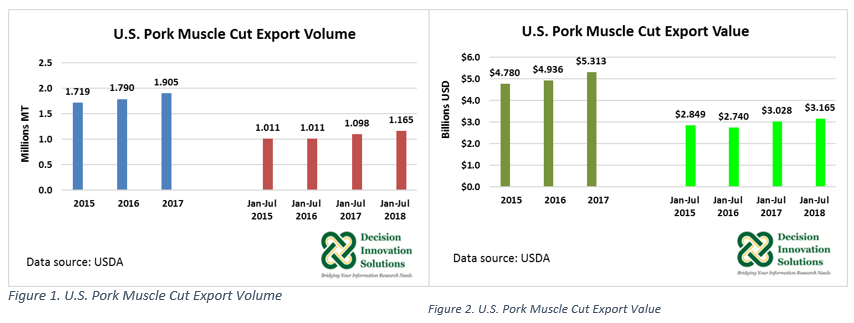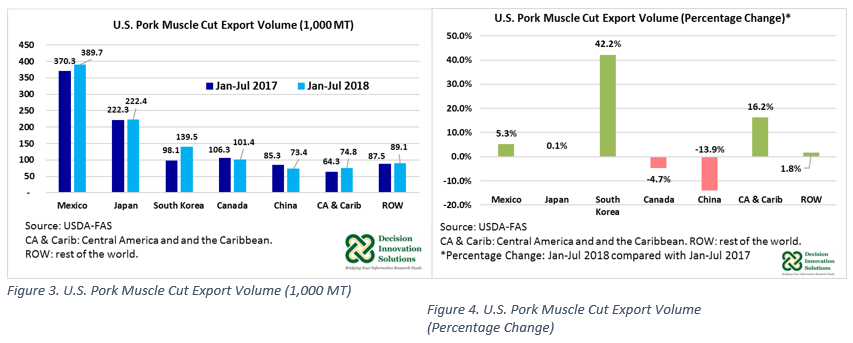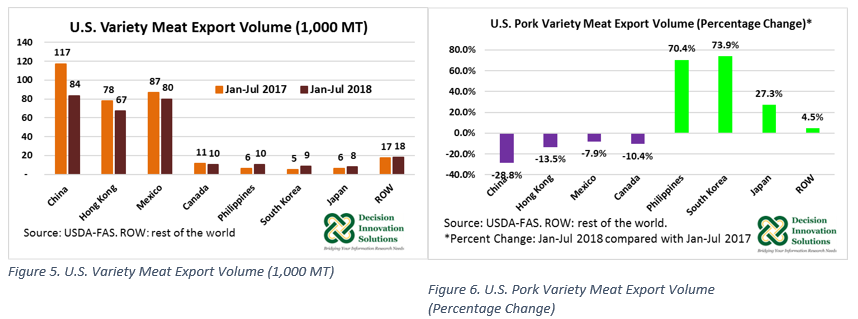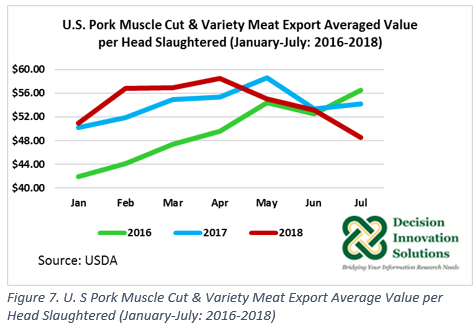posted by S. Patricia Batres-Marquez on Thursday, October 4, 2018
U.S. Pork Muscle Cut Exports (January to July 2018)
U.S. pork muscle cut export volume increased 6 percent to 1.165 million metric tons (MT) during the first seven months of 2018 compared with the same period last year (see Figure 1). The corresponding U.S. pork muscle cut export value was up 5 percent to $3.165 billion year over year (see Figure 2).

U.S. Pork Muscle Cut Exports by Country (January to July 2018)
U.S. pork exports during the first seven months of 2018 were boosted by increased shipments to Mexico, the number one volume market for U.S. pork, South Korea, and the Central American and Caribbean region (see Figure 3 and Figure 4). From January to July 2018, U.S. pork exports to Mexico increased 5.3 percent to 389,731 MT, representing one third of all U.S. pork exports during that period; however, exports to Mexico have been declining since May 2018. July exports to that market were down 29 percent to 47,041 MT from the shipment in April (66,685 MT). Note that in June 2018, Mexico started to impose retaliatory tariffs on several U.S. pork products. Since July 5th, Mexico’s retaliatory tariffs for U.S. chilled & frozen (bone-in & boneless) pork cuts and other processed pork were raised from 0 to 20 percent, while the tariff for U.S. pork sausages was increased from 0 to 15 percent.
U.S. pork exports to South Korea, the third largest volume market for U.S. pork muscle cuts, were up 42.2 percent to 139,504 MT during the first seven months of 2018 compared with the same period the previous year. At the same time, exports to the Central American and the Caribbean region increased 16.2 percent to 74,752 MT (see Figure 3 and Figure 4).
U.S. pork exports to China during the first seven months of 2018 fell 13.9 percent to a volume of 73,400 MT year over year. Since April 2, 2018, China has been imposing retaliatory tariffs on several U.S. pork and products, which are having a negative impact on U.S. pork exports to that country. On July 6, tariffs imposed on U.S. fresh or chilled pork muscle cut products were in the 35 and 70 percent range, whereas tariffs on fresh of chilled edible pork offal products were in the 45 to 70 percent range. Starting on September 24, China imposed an additional 10 percent on hog casings (salted, excluding hog fat-ends) and pork stomachs to the existing 20 percent tariff. China is currently the fifth main market for U.S. pork muscle cuts.
From January to July 2018, U.S. pork exports to Japan (222,413 MT) remained about the same as last year (January to July). Nineteen percent of U.S. total pork exports were shipped to Japan during the first seven months of 2018. Japan is the top value market for U.S. pork. Exports to that market were valued at $928.035 million, up 1 percent from last year (January to July). Based on volume, Japan is the second largest market for U.S. pork (see Figure 3 and Figure 4).

U.S. Pork Variety Meat Exports (January to July 2018)
Retaliatory tariffs on U.S. pork variety meats imposed by China are already impacting U.S. pork variety meat exports this year. From January to July 2018, shipments to China, the leading market for U.S. variety meat, were down 28.8 percent to 83,586 MT. Twenty nine percent of all U.S. pork variety meat exports ended in the Chinese market during that period. This share declined from 35.8 percent in 2017 (January to July 2017).
The volume of shipments to other important markets for U.S. variety meats fell as well during this year. From January to July 2018, exports to Hong Kong and Mexico were down 13.5 and 7.9 percent, respectively, compared with the first seven months of 2017 (see Figure 5 and Figure 6). Exports to China, Hong Kong, and Mexico represented 80.7 percent of total shipments (January through July 2018). With exports to these three leading markets shrinking during the first seven months of 2017, U.S. total pork variety meat export volume fell 12.8 percent to 286,201 MT. The value of those exports dropped 1.3 percent to $660.545 million compared with the same period last year. Although exports to the Philippines, South Korea, Japan, and other markets (ROW) increased during January through July 2018, shipments to those markets represented only 15.7 percent of total U.S. pork variety meat exports. Exports to Canada (10,217 MT) amounted to 3.6 percent of total U.S. pork variety meat exports. Exports to the Canadian market were down 10.4 percent during January to July of this year relative to 2017 (January to July).

As Figure 7 shows, with U.S. pork exports declining since April 2018, the average value of pork exports has deteriorated. July pork export value averaged $48.49 per head slaughtered, down 10.6 percent from a year ago ($54.22 per head) and 14.1 percent below 2016 ($56.47 per head).

2018 Pork Outlook
USDA (WASDE, September 2018) pork production forecast for 2018 (26.688 billion pounds) was slightly (0.1 percent) down from the previous month projection (26.723 billion pounds). Compared with 2017 (25.598 billion pounds), the 2018 production projection was up 4.3 percent. With the expected large 2018 production, pork prices are expected to contract, while domestic and foreign demand are projected to increase in response to lower prices. USDA’s September price projection indicates prices would decline 13.8 percent to a range of $43 to $44/cwt (National base cost, 51-52 % lean, live equivalent) compared with last year ($50.48/cwt). Domestic per capita consumption is projected to increase this year by 1.4 pounds to 51.5 pounds year over year. The 2018 pork export forecast shows a 6.3 percent increase to 5.989 billion pounds compared with 2017.
Recent Trade News
USDA’s recent announcements on September 24, September 26, and October 1 are good news to the U.S. meat industry, in particular, and U.S. agriculture in general. The September 24th announcement was regarding the signing of the revised Korea-U.S. Free Trade Agreement (KORUS). Note that through KORUS, most pork products enter already duty free in the South Korean market, but the signing of a revised agreement gives stability and new opportunities in this important market.
The September 26th news release was about an agreement between the United States and Japan to begin negotiations for a U.S.-Japan Trade Agreement. Japan is the number one value market for U.S. pork. Last December, Japan and the European Union (EU) concluded negotiations on the Japan-EU economic partnership. This partnership allows duty free or reduced duty on EU pork and products entering the Japanese market, while technically making U.S. pork more expensive in that valuable market; therefore, a free trade agreement between the United States and Japan would strengthen the U.S. pork position in the Japanese market and would reduce competition from EU pork and products.
Finally, the October 1, 2018, announcement was regarding news of a United States-Mexico-Canada Agreement (USMCA). USMCA is the name for a revised North America Free Trade Agreement (NAFTA). As of now, details of USMCA are yet to be announced, but preliminary information indicates USMCA includes elimination of Canada’s Class 7 dairy pricing program and more access to Canada’s dairy market. Also, U.S. poultry and egg products are expected to gain more access in the Canadian market. Due to NAFTA, U.S. pork enters the Canadian market duty free. That was the case in the Mexican market too before retaliatory tariffs. Details about the treatment of Mexico’s current retaliatory tariffs on U.S. pork have not been released yet. Currently, based on volume, Mexico and Canada are number one and number four markets for U.S. pork, respectively.
This report was originally published here: https://www.iowafarmbureau.com/Article/US-Pork-Exports-Increased-in-July-While-Mexico-and-China-Tariffs-Continued
- canada
- china
- japan
- mexico
- pork
- south korea